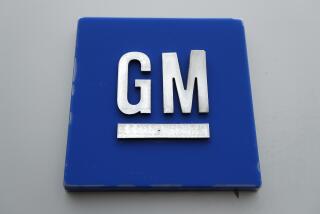10 ways to spot trouble
- Share via
You don’t have to be a mechanic to spot issues with a car. Here are 10 easy things to look for from Carey Caldwell, purchasing manager for used-car chain CarMax. Above all, he says: “Don’t be afraid to ask hard questions when you find something funny.”
1. Take a whiff.
Sit in the car with the door closed and inhale through your nose. If you smell mildew or anything musty, Caldwell says, the car might have been flooded, a big problem.
2. Look for signs of water.
Check the bolts holding the seats to the floor. If the car has flooded they’ll probably show signs of rust. Next, inspect the seat belts. Pull them out all the way and examine them for dried silt or water lines.
3. Listen to the engine.
Start the motor and let it run a few minutes. Lift the hood and listen. If the engine idles smoothly without any inconsistent running, grinding or knocking sounds, that’s good. “Metal on metal is not a good thing to hear,” Caldwell says.
4. Watch for signs of big repairs.
While the hood is up, look for structural repairs. Check the bolts that hold on the fenders. If they show signs of being turned, such as scuffed paint, that may indicate work was done. “It might mean this vehicle was damaged.”
5. Check for VIN issues.
Each car has a unique vehicle identification number, and there’s always one on the driver’s side of the dashboard, visible through the windshield. Increasingly there are VIN stickers on the car’s body panels. If none have it, don’t worry, but if most do and some don’t that could be a sign of major repairs. While you’re at it, Caldwell says, compare the VINs; they should all match.
6. Kneel down.
Look under the car at the bottom of the motor and transmission area. If you see dents or major scrapes, it could mean the car drove over something too high, and could spell serious mechanical damage. Check the metal rails near the sides of the passenger area. They’re used to attach frame-repair machines used to straighten a damaged chassis. If that’s the case, you’ll see marks or gouges in the metal. “It’s like a vise grip. You can’t miss it,” Caldwell says.
7. Take her for a spin.
Drive the car a few miles and check all the little systems -- radio, windshield wipers, heat, air conditioning, headlights, etc. Make sure that the odometer turns. If it’s stuck, Caldwell says, “who knows how many miles are really on this car?”
8. Ask for paperwork.
If the owner has records of oil changes and emissions inspections, that’s a sign the car has been routinely maintained. Make sure the mileage numbers on the work orders seem consistent with the odometer.
9. Pop the trunk.
Make sure it has a spare tire and jack. Remove them and, if you can, lift any carpeting to inspect the metal below. Damage here is an indicator of a rear-end collision. Lift the carpeting on the trunk’s sides and look for signs that body panel welds have been broken or rewelded.
10. Check out the tires.
Are they worn evenly? Excessive wear on one side could indicate alignment or suspension problems, which can be very expensive to fix. Drive the car and see if it pulls to one side.
Finally . . .
If everything checks out, Caldwell says, you’re still not done. Some problems only a mechanic can spot. Have the car inspected at a garage of your choice, which should cost $50 to $150. If the seller balks, he says, “find some other car.”
More to Read
Inside the business of entertainment
The Wide Shot brings you news, analysis and insights on everything from streaming wars to production — and what it all means for the future.
You may occasionally receive promotional content from the Los Angeles Times.










